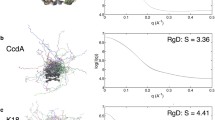Abstract.
Computer simulations at the atomic level have arrived at a stage where they provide realistic modeling of flexibility in proteins (and the mobility of their associated solvent) that is important in understanding the nature of molecular motions. This can now be extended to the molecular and atomic motions that are associated with protein mechanisms. Moreover, the derived data agree reasonably accurately with experimental measurements of several kinetic and thermodynamic parameters. Fundamental insights emerge on the roles that this intrinsic flexibility plays in the thermodynamic characteristics of macromolecules in solution; these equip the investigator to probe the consequences of cognate interactions and ligand binding on entropy and enthalpy. Thus simulations can now provide a powerful tool for investigating protein mechanisms that complements the existing and the emerging experimental techniques.
Similar content being viewed by others
Author information
Authors and Affiliations
Corresponding author
Additional information
Received 29 May 2005; received after revision 23 August 2005; accepted 21 October 2005
Rights and permissions
About this article
Cite this article
Dodson, G., Verma, C.S. Protein flexibility: its role in structure and mechanism revealed by molecular simulations. Cell. Mol. Life Sci. 63, 207–219 (2006). https://doi.org/10.1007/s00018-005-5236-7
Published:
Issue Date:
DOI: https://doi.org/10.1007/s00018-005-5236-7




